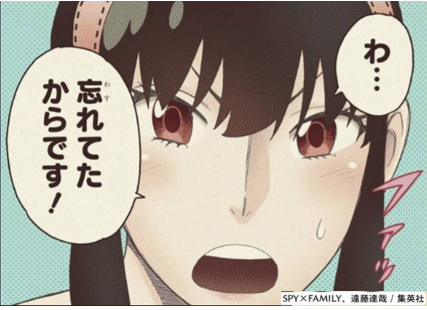First, let's learn Japanese greetings. Greetings are very important communication in any country. Besides, greeting…
Explanation of reason 4 and 5, why “SPYxFAMILY” is useful for studying Japanese
4. Anya makes mistakes in Japanese, just like a child in Japan or a beginner learner of Japanese learns. Study Anya’s mistakes and learn correct expressions.
Anya’s mistakes come in many varieties. There are too many, so we will explain in detail when you study Anya’s lines one by one in the future. This time, we will write down what kind of mistakes there are. You see a few grammar words, but don’t worry, We’ll explain them later.
- Mistake in leaving out a particle
- Japanese language does not have prepositions like Western languages. Instead, there are “particles”. Prepositions go before the words they form a phrase with, while particles go after them. Anya often skips “particles”. The important point is that the Japanese people still understand what Anya is saying without “particles”.
- Mistakes in pronunciation, in choosing words
- Anya repeats the same mistakes. But Japanese readers enjoy them as “Anya-go(Anya’s language)”, words created by Anya.
- Mistakes in predicate conjugation for polite expressions and in choosing appropriate words, for polite expressions
- How to create polite expressions in Japanese? You can do it connecting nouns with polite words, also conjugating adjectives (い-adjectives and な-adjectives) y verbs (predicate) and connect them with polite words, etc. Anya often makes mistakes in conjugation.
5. Yor always speaks in polite style of speech to everyone.

Yor speaks in polite style of speech to her own little brother Yuri and the dog, Bond. The black letters below are polite words with which you can make “polite style of speech”.
Casual (Tameguchi) : “ボンド、ごはんできたよー!”
Polite style of speech : “ボンドさん、ごはんできましたよー!“
In modern Japan, people use casual words and expressions among family and close friends. Among young people in Japan, the casual way of speaking is called “Tameguchi”. “Tame” is a slang word that means “same age”. “Tameguchi” has a good rhythm and can also express intimacy. When you used “Tameguchi” with someone, It means that you think the person is very close and on an equal footing with you.
However, if you are on an equal footing with someone but you meet the person for the first time, or you have known the person for a long time but are not as close as a friend, you should add polite words such as “desu” and “masu” at the end of the sentence in Japanese. Beginner level students at Japanese language schools learn these polite expressions first and “Tameguchi” later. The first people the students talk to when they come to Japan are staff at airports, at shops or at school, etc. They are on “equal footing” with the students, but are not as close as friends.
By the way, these days, because of the development of transportation and Internet in the world, there are many people who have Japanese friends before they start to study Japanese Language or first visit to Japan. Therefore, many people want to learn “Tameguchi” first. If you are self-taught of Japanese using Manga/Anime and want to learn “tameguchi” first, that’s good. But, please keep in mind that in Japan, even if you are on an equal footing, some people are better off using polite expressions.
Well, Yor uses polite language with Yuri, who is her own younger brother and is very close to her. So does Bond, the dog. This is one of Manga’s exaggerations. The author, Endo-sensei, uses this to express Yor’s kind and warm personality towards everyone around.
If you want to learn polite expressions, imitate Yor! Anya also uses polite expressions correctly from time to time. We will introduce a simple conversation with Anya and Yor etc. in our blog.
Honorific expression (Keigo)
There are two other types of polite expressions in Japanese.
Respectful expression (Sonkeigo) that refer to the other person’s movement or state by looking up at them
Humble expression (Kenjyougo) used to refer to one’s own actions and conditions by lowering oneself below the other person’s
For example, in a company, subordinates use these against their superiors, or shopkeepers use these against customers. We will study these together later.
Honorific expression (Keigo) is a generic term for Polite expression, Respectful expression and Humble expressioin.
Yahooo!!! You are now ready to go. From the next post, let’s learn from the lines in “SPYxFAMILY” !
You can buy Japanese ver. of『SPYxFAMILY』with format Kindle at Amazon.co.jp.
If you live in Japan, you can watch Japanese ver. of『SPYxFAMILY』 with Amazon Prime Video at Amazon.co.jp. If you live abroad, try to find at Netflix, Hulu etc.
⇒ Next post is “SPYxFAMILY” in Japanese #6!
